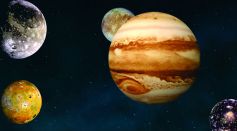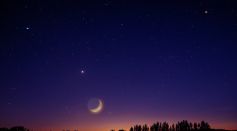Tags: Jupiter

Distant Giant Planets Begin as Flattened Disks, Transforming into Round Shapes Over Time

NASA Juno Spacecraft Snaps Shots of Jupiter's Volcanically Active Io Moon
What's Inside Ganymede? Iron Snow Experiments Shed Light on the Magnetic Dance Within Jupiter's Largest Moon

Juno Probe Reveals Closest-Ever View of Jupiter's Volcanic Moon Io, Unveiling Ongoing Volcanic Activity in Stunning Detail

Winter Solstice 2023 Is Coming: Jupiter, Bright Moon To Shine Together During the Longest Night of the Year in the Northern Hemisphere
Giant Hole in Sun Wider Than 60 Earths, 5 Times Jupiter’s Diameter Spewing Powerful Solar Wind
ESA’s JUICE Probe Set To Use First-Ever Double Gravity Assist for Launch to Jupiter

Jupiter's Celestial Spectacle: Amateur Astronomer Captures Explosive Collision of Bolide Comet in Mesmerizing Video

Spectacular Solar Eclipse, Historic Launch, and Jupiter's Wonders: An Unforgettable Week in the Skies
Space Photo of the Week: NASA's Juno Spacecraft Captures Up Close Photo of Jupiter's Volcanic Moon Io at 7,260 Miles
JWST Discovers Dozens of Planet-Like Objects Untethered to Any Star in Trapezium Cluster
Jupiter’s Moon Europa May Hold Carbon in Ocean Beneath Its Icy Shell [Study]

Moon To Align With Uranus, Jupiter, and More: Here's What To Look Forward to in the Night Sky This Week
Bacterial Spores May Grow on the Frigid Environment of the Icy Moons of Jupiter and Saturn, Could Hold the Key to Finding Extraterrestrial Life
NASA’s Juno Spacecraft Frequently Encounters Giant Swirling Waves at Boundary Between Solar Wind, Jupiter’s Magnetosphere [Study]

Jupiter-Like Exoplanet Defies Doom Even After a Cosmic Cataclysm at the Hands of Its Own Sun
Ghostly Lightning in Jupiter Captured by NASA Juno Spacecraft; How Does the Space Probe Provide New Insights About the Gas Giant?
Jupiter’s Ocean Moon Europa Lacks Fully Formed Metallic Core [Study]
Planetary Alignment: 5 Planets Jupiter, Saturn, Mercury, Neptune, Uranus Will Make Rare Appearance in the Sky This Weekend

Hot Jupiters May Not Always Be Alone: New Research Challenges Isolation Assumption, Unveils Surprising Exoplanet Companions
Most Popular

Largest Known Volcanic Aquifer Discovered Beneath Oregon's Cascades

New 'Supergiant' Sea Bug Found in South China Sea, Named After Darth Vader

Mediterranean Sea Was Refilled by a Catastrophic Flood Millions of Years Ago

Mysterious Cosmic Waves That Sound Like Birds Detected in Unexpected Space Region





